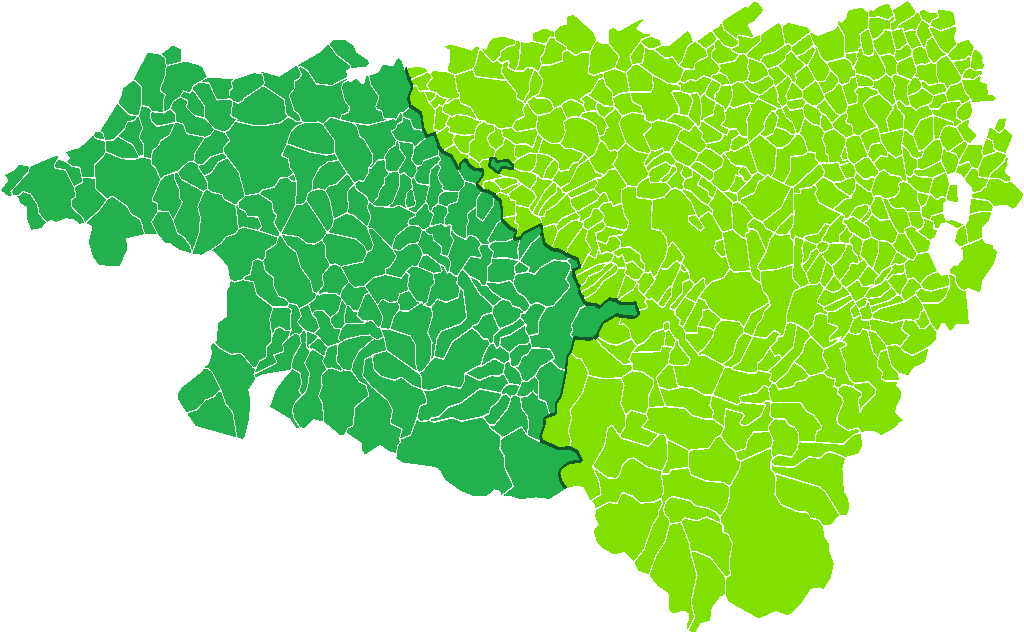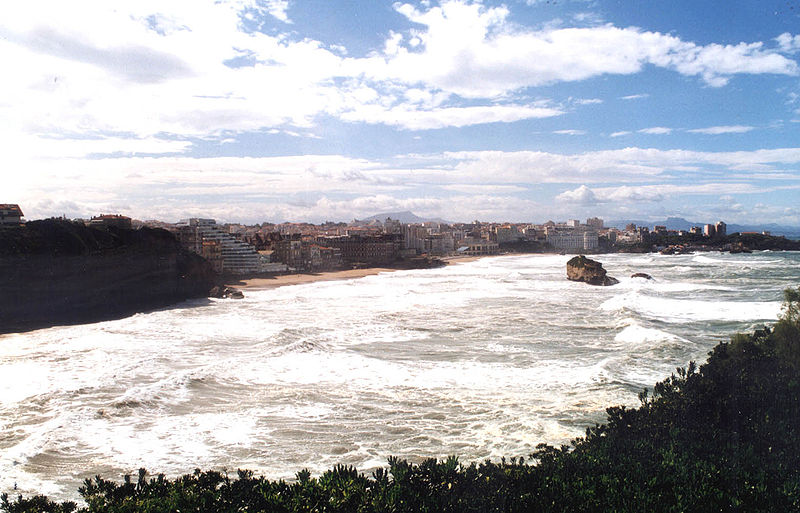|
Labourd
Labourd ( eu, Lapurdi; la, Lapurdum; Gascon: ''Labord'') is a former French province and part of the present-day Pyrénées Atlantiques ''département''. It is one of the traditional Basque provinces, and identified as one of the territorial component parts of the Basque Country by many, especially by the Basque nationalists. Labourd extends from the Pyrenees to the river Adour, along the Bay of Biscay. To the south is Gipuzkoa and Navarre in Spain, to the east is Basse-Navarre, to the north are the Landes. It has an area of almost and a population of over 200,000 (115,154 in 1901; 209,913 in 1990), the most populous of the three French Basque provinces. Over 25% of the inhabitants speak Basque (17% in the Bayonne-Anglet-Biarritz zone, 43% in the rest). Labourd has also long had a Gascon-speaking tradition, noticeably next to the banks of the river Adour but also more diffusely throughout the whole viscounty (about 20% in Bayonne-Anglet-Biarritz). The main town of Labourd ... [...More Info...] [...Related Items...] OR: [Wikipedia] [Google] [Baidu] |
Northern Basque Country
The French Basque Country, or Northern Basque Country ( eu, Iparralde (), french: Pays basque, es, País Vasco francés) is a region lying on the west of the French department of the Pyrénées-Atlantiques. Since 1 January 2017, it constitutes the Basque Municipal Community ( eu, Euskal Hirigune Elkargoa, links=no; french: Communauté d'Agglomeration du Pays Basque, links=no) presided over by . It includes three former historic French provinces in the north-east of the traditional Basque Country totalling : Lower Navarre (french: Basse-Navarre, links=no; eu, Nafarroa Beherea, links=no), until 1789 nominally Kingdom of Navarre, with ; Labourd (), with ; Soule (), with . The population included in the Basque Municipal Community amounts to 309,723 inhabitants distributed in 158 municipalities. It is delimited in the north by the department of Landes, in the west by the Bay of Biscay, in the south by the Southern Basque Country and in the east by Béarn (although in the Bé ... [...More Info...] [...Related Items...] OR: [Wikipedia] [Google] [Baidu] |
Bayonne
Bayonne (; eu, Baiona ; oc, label= Gascon, Baiona ; es, Bayona) is a city in Southwestern France near the Spanish border. It is a commune and one of two subprefectures in the Pyrénées-Atlantiques department, in the Nouvelle-Aquitaine region. Bayonne is located at the confluence of the Nive and Adour rivers in the northern part of the cultural region of the Basque Country. It is the seat of the Communauté d'agglomération du Pays Basque which roughly encompasses the western half of Pyrénées-Atlantiques, including the coastal city of Biarritz. This area also constitutes the southern part of Gascony, where the Aquitaine Basin joins the beginning of the Pre-Pyrenees. Together with nearby Anglet, Biarritz, Saint-Jean-de-Luz, as well as several smaller communes, Bayonne forms an urban area with 273,137 inhabitants at the 2018 census; 51,411 residents lived in the commune of Bayonne proper. [...More Info...] [...Related Items...] OR: [Wikipedia] [Google] [Baidu] |
Lapurdian
Navarro-Labourdin or Navarro-Lapurdian ( eu, nafar-lapurtera) is a Basque dialect spoken in the Lower Navarre and Labourd (Lapurdi) former provinces of the French Basque Country (in the Pyrénées Atlantiques ''département''). It consists of two dialects in older classifications, Lower Navarrese and Labourdin. It differs somewhat from Upper Navarrese spoken in the Peninsular Basque Country. Lower Navarrese or Low Navarrese (Standard Basque: ''behe-nafarrera'') is actually two subdialects, eastern and western; the western dialect continues into eastern Labourd. Labourdin (French ''labourdin''; Standard Basque ''lapurtera'', locally ''lapurtara'') is spoken in western Lapurdi. Labourdin is felt by speakers of other dialect to be clear-cut and elegant, retaining like other northern Basque dialects the consonant , and it was used along with Gipuzkoan and High Navarrese in the creation of the Batua, a standardised form of Basque intended for teaching and the media. Classic Lab ... [...More Info...] [...Related Items...] OR: [Wikipedia] [Google] [Baidu] |
Basque Country (greater Region)
The Basque Country ( eu, Euskal Herria; es, País Vasco; french: Pays basque) is the name given to the home of the Basque people. Trask, R.L. ''The History of Basque'' Routledge: 1997 The Basque country is located in the western Pyrenees, straddling the border between France and Spain on the coast of the Bay of Biscay. ''Euskal Herria'' is the oldest documented Basque name for the area they inhabit, dating from the 16th century. It comprises the Autonomous communities of Spain, Autonomous Communities of the Basque Country (autonomous community), Basque Country and Navarre in Spain and the Northern Basque Country in France. The region is home to the Basque people ( eu, Euskaldunak), their Basque language, language ( eu, Euskara), culture and traditions. The area is neither linguistically nor culturally homogeneous, and certain areas have a majority of people who do not consider themselves Basque, such as the south of Navarre. The concept is still highly controversial, and the ... [...More Info...] [...Related Items...] OR: [Wikipedia] [Google] [Baidu] |
Pyrénées-Atlantiques
Pyrénées-Atlantiques (; Gascon Occitan: ''Pirenèus Atlantics''; eu, Pirinio Atlantiarrak or ) is a department in the southwest corner of France and of the region of Nouvelle-Aquitaine. Named after the Pyrenees mountain range and the Atlantic Ocean, it covers the French Basque Country and the Béarn. Its prefecture is Pau. In 2019, it had a population of 682,621.Populations légales 2019: 64 Pyrénées-Atlantiques INSEE History Originally named Basses-Pyrénées, it is one of the first 83 created during the |
Hasparren
Hasparren (; eu, Hazparne) is a commune in the Pyrénées-Atlantiques department in south-western France. A resident of Hasparren is known as a 'Hazpandar'. Geography Location It's a ''commune fait partie'' of the Basque Province of Labourd. The Côte Basque (''Euskal Kostaldea)'', is 25 km to the west. Access Hasparren is located on the route D 10, between La Bastide-Clairence and Cambo-les-Bains, at the crossroads with D 21, D 22 and D 23. It has got access to autoroute A 64, exit 4 near Briscous. Hydrography The rivers Ardanabia and Suhihandia (a tributary of the Aran), flow through the commune. Locations Eight settlements compose the Commune of Hasparren: * Labiri ; * Elizaberri ; * la Coste (la Côte sur les cartes IGN) ; * Peña (Pegna sur les cartes IGN) ; * Minhotz ; * la Ville ; * Urcuray ; * Bas-Labiri et Zelhaia . Toponymy Ancient attestations It is attestested with various words: ''Hesperenne'' (1247 in Cartulaire de Bayonne) ' ... [...More Info...] [...Related Items...] OR: [Wikipedia] [Google] [Baidu] |
Saint-Jean-de-Luz
Saint-Jean-de-Luz (; eu, Donibane Lohitzune,Donibane Lohitzune es, San Juan de Luz, oc, Sent Joan de Lus, ) is a in the , southwestern France. Saint-Jean-de-Luz is part of the |
Anglet
Anglet (; , eu, Angelu )ANGELU Auñamendi Eusko Entziklopedia is a commune in the department in the region of southwestern France. Anglet lies in the traditional province of Labourd of the Northern Basqu ... [...More Info...] [...Related Items...] OR: [Wikipedia] [Google] [Baidu] |
Biarritz
Biarritz ( , , , ; Basque also ; oc, Biàrritz ) is a city on the Bay of Biscay, on the Atlantic coast in the Pyrénées-Atlantiques department in the French Basque Country in southwestern France. It is located from the border with Spain. It is a luxurious seaside tourist destination known for the Hôtel du Palais (originally built for the Empress Eugénie circa 1855), its casinos in front of the sea and its surfing culture. Geography Biarritz is located in the Pyrénées-Atlantiques department in the Nouvelle-Aquitaine region. It is part of the arrondissement of Bayonne. It is adjacent to Bayonne and Anglet and from the border with Spain. It is in the traditional province of Labourd in the French Basque Country. Gallery File:Édouard_Zier_-_Les_baigneuses_à_Biarritz.jpg, ''Les baigneuses à Biarritz'', by Édouard François Zier File:Biarritz1999.jpg, Biarritz from the Pointe Saint-Martin. File:Grande Plage de Biarritz.jpg, ''La Grande Plage'', the town ... [...More Info...] [...Related Items...] OR: [Wikipedia] [Google] [Baidu] |
Espelette
Espelette (; ; oc, Espeleta) is a commune in the Pyrénées-Atlantiques department in south-western France. It lies in the traditional Basque province of Labourd. Sights The town is attractive, with traditional Labourd houses and a castle. The protected sixteenth-century church, Saint-Etienne, has a Baroque altarpiece, and its graveyard has many traditional Basque discoidal tombstones. Notable people * Agnès Souret, the first woman ever chosen as Miss France, in 1920, is buried in Espelette. She died in Argentina, aged 26, in 1928, and her body was repatriated to Espelette by her mother, who sold most of her possessions to provide a resting place for her daughter. * Father Armand David (1826–1900), a Lazarist missionary Catholic priest as well as a zoologist and a botanist, was born in Espelette. Red peppers Espelette is known for its dried red peppers, used whole or ground to a hot powder, used in the production of Bayonne ham. The peppers are designated as Appellat ... [...More Info...] [...Related Items...] OR: [Wikipedia] [Google] [Baidu] |
Basse-Navarre
Lower Navarre ( eu, Nafarroa Beherea/Baxenabarre; Gascon/Bearnese: ''Navarra Baisha''; french: Basse-Navarre ; es, Baja Navarra) is a traditional region of the present-day French ''département'' of Pyrénées-Atlantiques. It corresponds to the northernmost ''merindad'' of the Kingdom of Navarre during the Middle Ages. After the Spanish conquest of Iberian Navarre (1512–24), this ''merindad'' was restored to the rule of the native king, Henry II. Its capitals were Saint-Jean-Pied-de-Port and Saint-Palais. In the extreme north there was the little sovereign Principality of Bidache, with an area of and a decreasing population of 44,450 (in 1901), 25,356 (in 1990). Although this denomination is not completely correct from the historical point of view, it is also known as ''Merindad de Ultrapuertos'' ("the regions beyond the mountain passes") by the southerners, and ''Deça-ports'' ("this side of the mountain passes") by the Gascon-speakers. Despite its lost administrative coh ... [...More Info...] [...Related Items...] OR: [Wikipedia] [Google] [Baidu] |
La Rhune
Larrun (modern French language, French: ''La Rhune'', IPA: [la'run], - 'good pasture', possibly a folk etymology, in French until the 20th century: ''Larhune'' ) is a mountain (905 m) at the western end of the Pyrenees. It is located on the border of France and Spain, where the traditional Basque Country (historical territory), Basque provinces of Labourd and Navarra meet. Its Topographic prominence, prominence is 670 m. History Larrun holds an iconic place in Basque people, Basque culture. It is covered in dolmens, stone circles and other neolithic monuments and was held to be a sacred place in Basque mythology. It was said to be the home of Lehensugea, the first serpent. Later, and perhaps as a consequence of the ancient sacred sites, the summit had a reputation as an ''Akelarre (witchcraft), akelarre'' or ritual meeting place for witches. Up until the 18th century, local villages paid for a monk to live as a hermit at the top of the mountain to keep witches away and ensure good ... [...More Info...] [...Related Items...] OR: [Wikipedia] [Google] [Baidu] |





